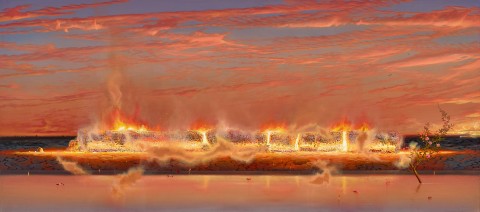THE LAMENT OF THE STREAM, 2000
TIM STORRIER
synthetic polymer paint on linen
107.5 x 244.5 cm
signed lower right: Storrier
signed and inscribed with title on stretcher bar verso: ‘The Lament of the Stream’ / Storrier.
Private collection, New South Wales, acquired directly from the artist
69 John Street, Sydney
Private collection, Sydney
Encompassing the subtlety of nature’s fugitive diurnal moods, its mysterious, silently unfolding rituals and vast droning presence, Tim Storrier’s iconic outback paintings evoke a poignant sense of place that is inextricably Australian. As Edmund Capon, a former director of the Art Gallery of New South Wales elucidates, ‘they could not, I believe have come from any country other than Australia’.1 Typically juxtaposing the element of fire against low horizons and expansive skies, indeed his evocations are indelible echoes of this brooding landmass – long-contemplated narratives inspired by Storrier’s own highly personal experience of the landscape, and enhanced by the alluringly beautiful texture and finish of his art. Utterly individual and exquisitely rendered, thus his interpretations feature among the most instantly recognisable and universally admired images in Australian art.
Upon first glance, The Lament of the Stream, 2000 mines familiar territory in Storrier's oeuvre, with the strong horizontal tension of the blazing horizon echoing his celebrated 'point to point' paintings of the 1980s. Yet despite such affinities, the composition reveals a significant shift in Storrier's vision towards the end of the millennium: where previously his evocations of fire had been literal and direct, these nocturnal landscapes 'announce a more sophisticated exploration of the emotive, melancholic mood that has always haunted Storrier's work.’2 Accordingly, the burning rope is here replaced by a burning log and the glowing embers of a vacated campsite, juxtaposed against an opalescent pink sky and sprig of delicate floral blooms. Betraying a fundamental concern with the tension between the decorative and representational function of art, the work is a meticulously composed, psychologically laden image which, though clearly derived from the natural world, nevertheless resonates with symbolic meaning and the artist's own deeply personal vision. Indeed, in the manner of European Romantic and Neoclassical predecessors such as David, Ingres, Casper Friedrich and Delacroix, Storrier here contemplates the insignificance of humankind when compared to the awesome magnitude of the natural world, drawing upon the symbolism of the fading light of day as a metaphor for change or the fin de siècle (end of an era), while the sensuous floral blooms poignantly allude to evolution, the passing of time and the grandeur of decay in the same vein as a traditional vanitas still life.
Like the finest of Storrier’s work, The Lament of the Stream, 2000 highlights the artist’s enduring interest in the dichotomy between classical and romantic, between the disciplined order of a painting’s surface and the submerged, darker implications of its subject. Disquietingly beautiful, the work encapsulates superbly the real power of Storrier’s unique vision; as Paul McGillick astutely elucidates, ‘…Tim Storrier’s art is about ambiguity and irony. It is never what it seems. Storrier’s critics have invariably been taken in by the surface charm of the work. What they have not appreciated… is the contradiction between Storrier’s pretty palette and the ugly, decaying and often violent imagery of the pictures.’3
1. Capon, E., quoted in Lumby, C., Tim Storrier: The Art of the Outsider, Craftsman House, Sydney, 2000, p.8
2. ibid., p.142 – 3
3. McGillick, P., ‘Culture shock for Paddo?’, Australian Financial Review, Sydney, 28 July 1989
VERONICA ANGELATOS
